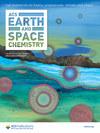Fe/Mg-Silicate Chemical Gardens as Analogs to Silicate-Rich Hydrothermal Chimneys on Early Earth and Mars
IF 2.9
3区 化学
Q2 CHEMISTRY, MULTIDISCIPLINARY
引用次数: 0
Abstract
Hydrothermal systems have been proposed as environments for prebiotic chemistry on early Earth. Ancient Mars had surface water and could also have had hydrothermal vents supporting biological or prebiotic processes. The Strýtan hydrothermal field (SHF) in Iceland is a basalt-hosted alkaline vent that forms massive hydrothermal Mg-saponite chimneys and is a potential analog to basalt-hosted alkaline vents that may have existed at the Eridania basin on Mars, where Fe/Mg-phyllosilicate deposits (e.g., saponite, talc, sepiolite, and serpentine) are thought to have formed from ancient hydrothermal activity. Chemical garden experiments have previously been used to simulate aspects of hydrothermal chimney growth for other types of vent systems; however, they have not been much used in this context of a silica-rich hydrothermal system. Here, we studied the formation of Fe/Mg-silicate injection chemical gardens simulating hydrothermal chimneys that represent analogs of precipitates that could have formed in SHF-like hydrothermal vents on early Earth and/or early Mars. We found that the Fe/Mg ratio of the exterior (ocean simulant) solutions influenced the simulated chimney chemistry under anoxic conditions and that the precipitates were enriched with Fe compared to the surrounding solution. Simulated chimney compositions as analyzed by Raman spectroscopy, scanning electron microscope-energy dispersive X-ray spectroscopy, X-ray diffraction, and visible–near-infrared reflectance spectroscopy were also affected by whether the chimneys were dried and/or heated post formation. Our data were suggestive of the presence of poorly ordered Mg-clay-like phases (e.g., sepiolite) in the simulated chimneys, along with amorphous/nanocrystalline Fe phases and Fe oxides/hydroxides, hydrated silica, hematite, halite, and gypsum. Saponite was not produced in our experiments because of an absence of Al in solution. Though we observed evidence for Mg-silicate and clay-like minerals in the chemical gardens, we only observed weak 12.5 Å peaks for Fe-silicate or Fe-containing clay-like minerals; however, amorphous silica and Fe oxides/hydroxides were confirmed, similar to what has been observed in previous chemical garden studies. This suggests that in SHF-like chimneys on early Earth and/or Mars, Mg would have been present as Mg-hydroxides and Mg-silicates (and, in the presence of additional geological components such as Al, likely saponite or other aluminous clay minerals), whereas Fe would be present as Fe or Fe:Mg-hydroxides. Such chimneys, containing both reactive Fe hydroxides as well as Mg-clay-like phases, would have increased potential for mineral-driven prebiotic chemical reactions.作为早期地球和火星富含硅酸盐热液烟囱类比物的铁/镁-硅酸盐化学花园
热液系统被认为是地球早期前生物化学的环境。古火星有地表水,也可能有支持生物或前生物过程的热液喷口。冰岛的 Strýtan 热液场(SHF)是一个形成大量热液镁皂石烟囱的玄武岩基底碱性喷口,有可能类似于火星 Eridania 盆地可能存在的玄武岩基底碱性喷口,那里的铁/镁-超硅酸盐沉积物(如皂石、滑石、霞石和蛇纹石)被认为是由古代热液活动形成的。化学园实验曾被用于模拟其他类型喷口系统的热液烟囱生长过程,但在富含二氧化硅的热液系统中还没有得到广泛应用。在这里,我们研究了模拟热液烟囱的铁/镁-硅酸盐注入化学园的形成,这些化学园代表了可能在早期地球和/或早期火星上类似于 SHF 的热液喷口中形成的沉淀物的类似物。我们发现,在缺氧条件下,外部(海洋模拟物)溶液的铁/镁比率影响着模拟烟囱的化学性质,与周围溶液相比,沉淀物富含铁。通过拉曼光谱、扫描电子显微镜-能量色散 X 射线光谱、X 射线衍射和可见光-近红外反射光谱分析的模拟烟囱成分还受到烟囱形成后是否干燥和/或加热的影响。我们的数据表明,在模拟烟囱中存在有序性较差的镁粘土相(如sepiolite),以及非晶/纳米晶铁相和铁氧化物/氢氧化物、水合二氧化硅、赤铁矿、海泡石和石膏。由于溶液中缺乏铝,我们的实验中没有产生皂石。虽然我们在化学花园中观察到了镁硅酸盐和类粘土矿物的证据,但我们只观察到了铁硅酸盐或含铁类粘土矿物的微弱的 12.5 Å 峰值;不过,无定形二氧化硅和铁氧化物/氢氧化物得到了证实,这与之前的化学花园研究中观察到的情况类似。这表明,在早期地球和/或火星上类似 SHF 的烟囱中,镁会以镁-氢氧化物和镁-硅酸盐的形式存在(如果存在其他地质成分,如铝,则可能是皂石或其他含铝粘土矿物),而铁则以铁或铁:镁-氢氧化物的形式存在。这种烟囱既含有活性铁氢氧化物,又含有类似镁粘土的相,因此矿物驱动的前生物化学反应的潜力更大。
本文章由计算机程序翻译,如有差异,请以英文原文为准。
求助全文
约1分钟内获得全文
求助全文
来源期刊

ACS Earth and Space Chemistry
Earth and Planetary Sciences-Geochemistry and Petrology
CiteScore
5.30
自引率
11.80%
发文量
249
期刊介绍:
The scope of ACS Earth and Space Chemistry includes the application of analytical, experimental and theoretical chemistry to investigate research questions relevant to the Earth and Space. The journal encompasses the highly interdisciplinary nature of research in this area, while emphasizing chemistry and chemical research tools as the unifying theme. The journal publishes broadly in the domains of high- and low-temperature geochemistry, atmospheric chemistry, marine chemistry, planetary chemistry, astrochemistry, and analytical geochemistry. ACS Earth and Space Chemistry publishes Articles, Letters, Reviews, and Features to provide flexible formats to readily communicate all aspects of research in these fields.
 求助内容:
求助内容: 应助结果提醒方式:
应助结果提醒方式:


